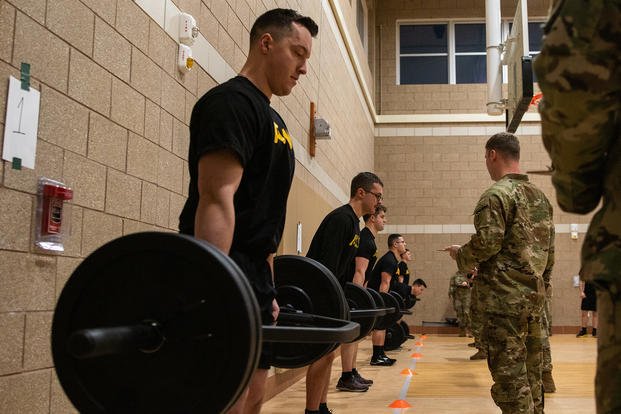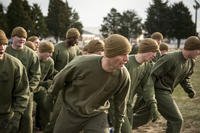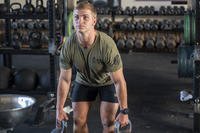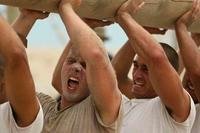Over the past month, I have asked various U.S. military candidates and active-duty personnel about their favorite workouts. Most of those questioned are working toward getting accepted into the military and later into a special operations program.
The level of intensity in this group is typically higher than average. However, the results show that many recruits and candidates have a favorite but must work on various weaknesses. Whether you are at an advanced level of fitness or a beginner, no one likes to do things they are not good at. Still, this group understands that weaknesses are exposed in military-type training (boot camp, selection, academy).
Lifting Weights
Many recruits and candidates have a history of strength and power training, speed and agility honed from various contact sports. Preparing for the military requires more endurance and muscle stamina for typical training days and testing events, so pulling these athletically strong recruits out of the weight room and introducing them to more calisthenics and cardio-based workouts is not easy.
But if you are going to be successful in future training, the foundation of strength training will help with durability and stability. Still, the focus on the natural weakness of a strength and power athlete cannot be ignored. It's time to get going with the classic PT Pyramid, super sets and max rep set workouts to progressively build calisthenics and endurance with running, rucking and swimming (if required).
High-Intensity Interval Training (HIIT)
Also a favorite of military candidates, these workouts are designed to improve cardiovascular endurance, muscular strength and overall physical fitness but tend to focus primarily on the higher end of the heart-rate zone. Training aerobically is also important as long days require an improved work capacity and the ability to recover quickly. Balance out higher and lower intensity and get the best of both sides of the fitness spectrum. See this heart-rate zone article for more information.
HIIT can be done with body-weight exercises, such as push-ups, pull-ups, mountain climbers and jumping jacks, or with equipment such as kettlebells, battle ropes and plyometric boxes. Mixing higher-repetition calisthenics with running, biking, rowing and even swimming is a great way to keep the heart rate and effort levels higher.
Long-Distance Running
Many of you enjoy running. Long-distance running and fast-paced timed run testing preparation is their happy-place, go-to workout. The endurance athlete preparing for military service, though, requires time under weights to build strength and should do calisthenics to work on upper-body muscle stamina.
The good news is that transitioning from an endurance athlete to a physical training, or PT, animal is quick, as the body can easily combine muscle stamina (high repetitions) with endurance training. However, the strength component is another story. Telling a runner to run less and lift more goes over the same as telling a strength athlete to lift less and run more. However, both athletes must make a small sacrifice to be more well-rounded and handle heavy load-bearing days, longer runs, rucks, and/or swimming and diving days.
Group PT
A large section of the group enjoys group PT sessions where an instructor leads them in exercises such as push-ups, pull-ups, sit-ups, plank poses, running and more. These include spin classes, yoga and other boot-camp fitness classes. In fact, see this video link of a summer seminar workout I led at the U.S. Naval Academy. This workout is geared for recruits new to military fitness and helps them understand the requirements of fitness standards and testing techniques.
Tactical fitness is a way of training that helps you become good at everything, versus excellent at one fitness element with opposite weaknesses. Remember, military training is focused on strength, power, speed, agility, muscle stamina, endurance (multiple modes), flexibility, mobility and grip. All these elements of fitness build needed components of durability, stability, work capacity and stress mitigation. This requires workouts that include a variety of calisthenics, weightlifting and cardiovascular exercises to build strength, agility and stamina.
As military candidates and active-duty military personnel, engaging in a diverse range of fitness training is crucial. This is not just about your favorite workouts but about developing a well-rounded athletic ability essential for military duties and career longevity. Remember, if you choose a military career, you'll spend more time being older than younger, significantly impacting your training needs as they need to evolve. Whether you're training for boot camp, preparing for a deployment or just striving to stay in optimal shape, a wide range of workouts that do not ignore personal weaknesses will help you reach your fitness goals and excel in your military career.
Want to Learn More About Military Life?
Whether you're thinking of joining the military, looking for fitness and basic training tips, or keeping up with military life and benefits, Military.com has you covered. Subscribe to Military.com to have military news, updates and resources delivered directly to your inbox.





















